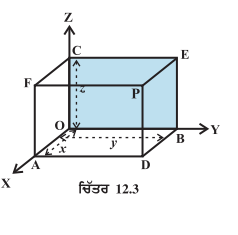ਉਹਨਾਂ ਅੱਠਵੇਂ ਹਿੱਸਿਆਂ ਦਾ ਨਾਂ ਦੱਸੋ ਜਿਹਨਾਂ ਵਿਚ ਹੇਠ ਲਿਖੇ ਬਿੰਦੂ ਹਨ: (1, 2, 3),(4, -2, 3), (4, -2,-5), (4, 2, -5), (- 4, 2, -5), (- 4, 2, 5), (-3,-1, 6) (-2,-4, -7)
Step by step video & image solution for ਉਹਨਾਂ ਅੱਠਵੇਂ ਹਿੱਸਿਆਂ ਦਾ ਨਾਂ ਦੱਸੋ ਜਿਹਨਾਂ ਵਿਚ ਹੇਠ ਲਿਖੇ ਬਿੰਦੂ ਹਨ: (1, 2, 3),(4, -2, 3), (4, -2,-5), (4, 2, -5), (- 4, 2, -5), (- 4, 2, 5), (-3,-1, 6) (-2,-4, -7) by Maths experts to help you in doubts & scoring excellent marks in Class 11 exams.
Updated on:21/07/2023Topper's Solved these Questions
- ਤ੍ਰੈ- ਵਿਮਾਈ ਜਿਆਮਿਤੀ ਦਾ ਅਸਥਾਪਨBOOK - PSEB (PUNJABI MEDIUM)CHAPTER - ਤ੍ਰੈ- ਵਿਮਾਈ ਜਿਆਮਿਤੀ ਦਾ ਅਸਥਾਪਨEXERCISE - EXAMPLE
13 Videos
- ਤਿਕੋਣਮਿਤੀ ਫਲਨBOOK - PSEB (PUNJABI MEDIUM)CHAPTER - ਤਿਕੋਣਮਿਤੀ ਫਲਨEXERCISE - EXAMPLE
29 Videos
- ਦੋ ਪਦੀ ਪਰਿਮੇਯBOOK - PSEB (PUNJABI MEDIUM)CHAPTER - ਦੋ ਪਦੀ ਪਰਿਮੇਯEXERCISE - EXAMPLE
12 Videos
Similar Questions
ਚਿੱਤਰ 12.3 ਵਿੱਚ P ਦੇ ਨਿਰਦੇਸ਼ ਅੰਕ (2,4,5) ਹਨ ਤਾਂ F ਦੇ ਨਿਰਦੇਸ਼ ਅੰਕ ਪਤਾ ਕਰੋ ।

View Solution40∘ 20' ਨੂੰ ਰੇਡੀਅਨ ਮਾਪ ਵਿੱਚ ਬਦਲੋ ।
View Solution(x2+3x)4,x≠0 ਦਾ ਪ੍ਰਸਾਰ ਕਰੋ।
View SolutionIf A=⎡⎢ ⎢ ⎢ ⎢⎣2315313234373223⎤⎥ ⎥ ⎥ ⎥⎦and B=⎡⎢ ⎢ ⎢ ⎢⎣23351152545736525⎤⎥ ⎥ ⎥ ⎥⎦, then compute 3A−5B.
View Solutionनिम्नलिखित श्रेढियों का योग अनन्त तक ज्ञात करो -
(A) 25−352+253−354+255−356+...... (दो श्रेढियों में तोड़ लो)
(B) (1+122)+(12+124)+(122+126)+....,
(C) 47−572+473−574+.....,
(D) 34−542+343−544+.....,
(E) 17+272+173+274+175+276+.....,
(F) 1+√2−12√3+3−2√212+5√2−724√3+.....
View Solutionनिम्नलिखित श्रेढियों का योग अनन्त तक ज्ञात करो -
(A) 25−352+253−354+255−356+...... (दो श्रेढियों में तोड़ लो)
(B) (1+122)+(12+124)+(122+126)+....,
(C) 47−572+473−574+.....,
(D) 34−542+343−544+.....,
(E) 17+272+173+274+175+276+.....,
(F) 1+√2−12√3+3−2√212+5√2−724√3+.....
View Solution" (iii) (−25+47)+(−25)(iv)34+76+(−54)+12
View Solutionयोगफल निकालिए :
32a3−14a2+73,−74a3+25a2−a+15 और −a3+4 का
View SolutionMake a frequency distribution of the following series. 1, 2, 2, 3, 3, 3, 3, 3, 4, 4, 4, 4, 4, 4, 4, 4, 4, 5, 5, 5, 5, 5, 5, 5, 6, 6, 6, 6, 7, 7.
View SolutionWhat should come next in the following number series
8 7 6 5 4 3 2 1 7 6 5 4 3 2 1 6 5 4 3 2 1
1) 6
2) 4
3) 7
4) 5
5) None of these
View SolutionWhat would come next in the following number sequence ? 2 3 2 3 4 2 3 4 5 2 3 4 5 6 2 3 4 5 6 7 2 3 4 1) 6 2) 5 3) 8 4) 9 5) None of these
View SolutionWhat will come next in the series given below ?
1 1 2 1 2 3 1 2 3 4 1 2 3 4 5 1 2 3 4 5 1 2 3 4 5 6 1 2 3 4 5 6 7 1 2 3 4 5
1) 1
2) 5
3) 6
4) 2
5) None of these
View SolutionThe number of the members in the 40 families in Bhilar are as follows :
1, 6, 5, 4, 3, 2, 7, 2, 3, 4, 5, 6, 4, 6, 2, 3, 2, 1, 4, 5, 6, 7, 3, 4, 5, 2, 4, 3, 2, 3, 5, 5, 4, 6, 2, 3, 5, 6, 4, 2. Prepare a frequency table and find the mean of members of 40 families.
View Solutionभिलार येथील 40 कुटुंबांतील सदस्यांची संख्या पुढीलप्रमाणे आहे : 1, 6, 5, 4, 3, 2, 7, 2, 3, 4, 5, 6, 4, 6, 2, 3, 2, 1, 4, 5, 6, 7, 3, 4, 5, 2, 4, 3, 2, 3, 5, 5, 4, 6, 2, 3, 5, 6, 4, 2, यावरून या 40 कुटुबातील सदस्यांचा मध्य वारंवारता सारणीचा वापर करून काढा.
View SolutionProve that: 212 x 313 x 41410−15 x 535 ÷343 x 5−754−35 x 6=10
View Solution5(5)/(6) + [2(2)/(3) - [3(3)/(4) (3(4)/(5) div 9(1)/(2))]]
View Solution
